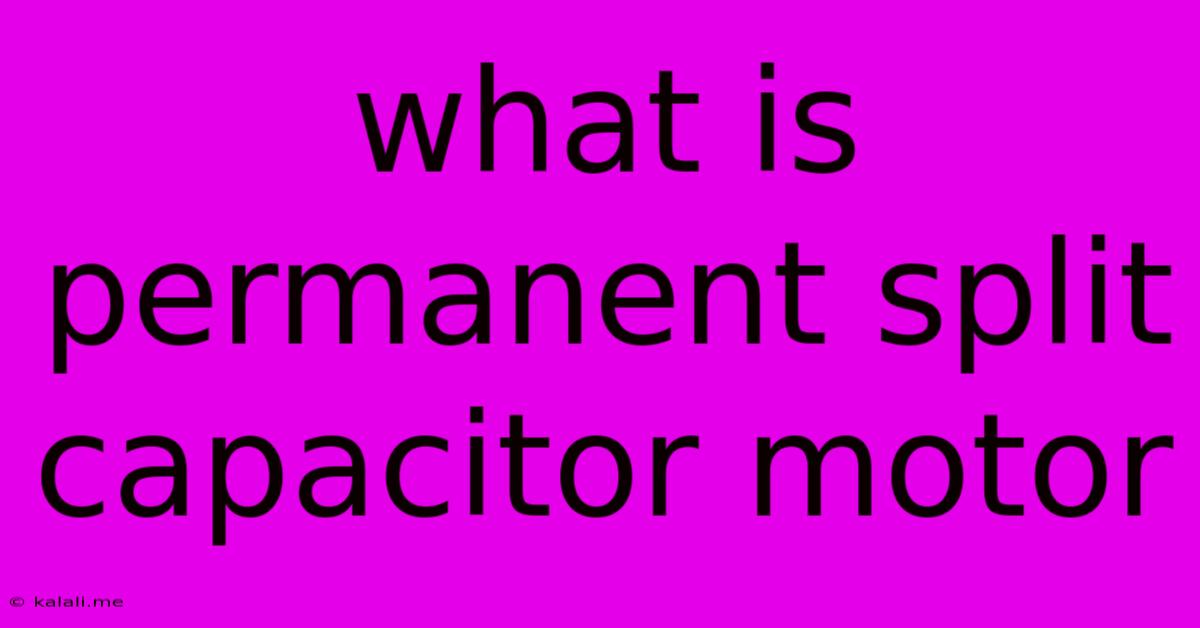What Is Permanent Split Capacitor Motor
Kalali
Jun 15, 2025 · 3 min read

Table of Contents
What is a Permanent Split Capacitor Motor? A Comprehensive Guide
This article dives deep into the workings of a permanent split capacitor motor (PSC motor), a common type of single-phase induction motor found in numerous household appliances and industrial applications. We'll explore its construction, operating principle, advantages, disadvantages, and typical applications. By the end, you'll have a thorough understanding of this ubiquitous motor type.
A permanent split capacitor motor is a type of single-phase AC motor characterized by its simple design and relatively low cost. It utilizes a capacitor permanently connected in series with the auxiliary winding to create a phase shift, allowing the motor to start and run. Unlike capacitor-start motors which disconnect the capacitor once the motor reaches a certain speed, the PSC motor keeps the capacitor engaged throughout its operation.
How Does a Permanent Split Capacitor Motor Work?
The heart of a PSC motor lies in its two windings: a main winding and an auxiliary winding. These windings are spatially displaced and have different impedances due to differing numbers of turns and wire gauges. A capacitor is permanently connected in series with the auxiliary winding. This capacitor alters the phase relationship between the currents flowing through the main and auxiliary windings, creating a rotating magnetic field.
This rotating magnetic field, although elliptical rather than perfectly circular, induces a torque in the rotor, causing it to start and rotate. The capacitor's presence not only aids in starting but also affects the motor's running characteristics, providing a smoother and quieter operation compared to some other single-phase motors.
The magnitude of the phase shift produced by the capacitor is crucial for both starting torque and running performance. A carefully selected capacitor value is essential for optimal efficiency. Too small a capacitor results in weak starting torque; too large a capacitor can lead to excessive current draw and reduced running efficiency.
Advantages of Permanent Split Capacitor Motors:
- Simple and Inexpensive: PSC motors have a relatively straightforward design, leading to lower manufacturing costs.
- Quiet Operation: The continuous presence of the capacitor contributes to quieter operation compared to capacitor-start motors.
- Self-Starting: These motors start reliably without requiring additional starting mechanisms.
- Compact Size: Due to the simple design, they often have a smaller footprint than other motor types.
- Easy Maintenance: Their simple construction translates to less complex maintenance requirements.
Disadvantages of Permanent Split Capacitor Motors:
- Lower Starting Torque: Compared to other single-phase motor types, they exhibit relatively lower starting torque. This limits their suitability for high-inertia loads.
- Lower Efficiency: Their efficiency is generally lower than other motor types, particularly at lower speeds.
- Sensitivity to Load: Their performance can be significantly affected by variations in load.
- Limited Speed Control: Speed control options are limited, typically requiring external methods such as variable voltage or frequency drives.
Typical Applications of Permanent Split Capacitor Motors:
PSC motors find widespread use in numerous applications where their low cost and ease of use outweigh their limitations:
- Fans: Ceiling fans, exhaust fans, and ventilation fans commonly utilize PSC motors.
- Blowers: Small blowers in heating and cooling systems often employ PSC motors.
- Small Pumps: These motors power small pumps in various applications.
- Household Appliances: PSC motors can be found in many household appliances, such as washing machines (for smaller models), dishwashers, and food processors.
- Small Power Tools: Some small power tools utilize PSC motors.
Choosing the Right Permanent Split Capacitor Motor
Selecting the appropriate PSC motor for a specific application involves careful consideration of several factors, including:
- Required Torque: The load's starting and running torque requirements.
- Speed: The desired operational speed of the motor.
- Voltage and Frequency: The available power supply characteristics.
- Size and Mounting: Physical constraints and mounting requirements.
- Environmental Conditions: Operating temperature and humidity.
In conclusion, the permanent split capacitor motor represents a reliable and cost-effective solution for numerous low-to-moderate torque applications. Understanding its operating principles and limitations is key to selecting the right motor for your specific needs. While not suitable for all applications, its simplicity and efficiency in many common tasks make it a ubiquitous and important component in modern technology.
Latest Posts
Latest Posts
-
Unprofessional Behavior Sample Warning Letter To Employee For Disrespectful
Jun 15, 2025
-
200 Degrees Centigrade Equals What In Fahrenheit
Jun 15, 2025
-
Gas Used In Fluorescent Light Bulbs
Jun 15, 2025
-
What Is The Least Common Multiple Of 27 And 36
Jun 15, 2025
-
What Is The Critical Pressure Of Steam
Jun 15, 2025
Related Post
Thank you for visiting our website which covers about What Is Permanent Split Capacitor Motor . We hope the information provided has been useful to you. Feel free to contact us if you have any questions or need further assistance. See you next time and don't miss to bookmark.